Resource A: Examples of 360-Degree Feedback
Influence Skills 360
OnPoint Consulting
Because the core processes of a business—ones that are responsible for creating end-products or services—cut across functions, the best and most efficient way to meet the customer’s needs is to improve the way in which people in these related functional areas work together. This collaboration enables the organization to accomplish goals and implement major change initiatives more quickly and with better quality than if each function operated as a separate “fiefdom.” Key to success in this environment is being able to work effectively with people across the organization, over which one may have no authority.
A ground-breaking research study, “Effects of Multisource Feedback and a Feedback Facilitator on the Influence Behavior of Managers Toward Subordinates,” (Journal of Applied Psychology, 2003, 88, 3, 561-569) by Dr. Gary Yukl, Charles F. Seifert, and Robert A. McDonald, demonstrates that OnPoint’s Influence Skills feedback instrument increases managers’ use of effective influence tactics and results in a positive change in their leadership behavior. The study also found that leaders perceive feedback to be more useful and easier to apply when it is delivered by a facilitator, rather than through a feedback report.
OnPoint’s Influence Skills 360-Degree, for anyone who works on a team or needs to work across organizational boundaries, focuses on the behaviors used by the most effective influencers. The influencing model includes eleven influence tactics:

The feedback report displays average scores for each tactic so people can compare their scores with those of others (Exhibit 1.1) and the distribution of scores for the specific behaviors to help them identify things they can do to be more effective (Exhibit 1.2).
When this is used in conjunction with the Influencing Skills Workshop participants:
• Learn to gain the commitment of people to plans and proposals by using logic and reasoning effectively, appealing to values and ideals with sensitivity and insight, and involving them in planning a strategy or activity
• Understand how people perceive their current use of the eleven influence tactics
• Use influence behaviors effectively to create an environment of support and collaboration with colleagues and associates
Workshops are customized to reflect an organization’s culture, environment, and goals. Customized case studies are used to relate workshop issues to those that people contend with day-to-day. Influencing Skills workshops are led by experienced OnPoint facilitators or by certified internal trainers. The modular nature of this stand-alone program allows for training flexibility, and it is easily integrated into existing leadership development programs.
Exhibit A.1 Influence Behavior Questionnaire, Overall Averages

For more information on Influence Skills Workshop and 360 and our other leadership development tools and solution go to our website at www.onpointconsultingllc.com and click on Products and Services.
Exhibit A.2 Influence Item Scores, Rational Persuation

Flexible Leadership 360
OnPoint Consulting
The Flexible Leadership 360, for senior and upper-middle managers, is based on Rick Lepsinger and Gary Yukl’s groundbreaking work, documented in their book, Flexible Leadership: Creating Value by Balancing Multiple Challenges and Choices. To provide guidance for managers in today’s dynamic, competitive marketplace, we integrated ideas from earlier leadership theories with ideas from theories of organizational effectiveness, organizational change, strategic management, and traditional management. Our model of flexible, adaptive leadership incorporates practitioner insights as well as findings from more than a half-century of empirical research.
We explain how leaders at all levels can enhance the determinants of organizational performance, which include Executing Plans and Initiatives, Leading and Managing People, and Adapting and Innovating. The thirty-six-item Leadership Survey measures the leader behaviors aligned with these three key determinants of organizational performance.
The results of this instrument provide leaders with a comprehensive report that outlines their strengths, as well as areas that may not be fully leveraged (Exhibits A.3, A.4, A.5 ).The Flexible Leadership 360 helps leaders prepare to deliver consistently high levels of performance and sustainable results over time. It helps leaders:
• Become familiar with the factors that impact organizational performance and the behaviors that effective leaders use to enhance the performance of their work units
• Clarify which leader and manager behaviors are essential to the success of their organization, and understand how others perceive their current use of these behaviors
• Learn how to establish the proper balance among trade-offs and leadership paradoxes that, on the surface, appear to be mutually exclusive
For more information on Flexible Leadership Workshop and 360 and our other leadership development tools and solutions go to our website at www.onpointconsultingllc.com and click on Products and Services.
Exhibit A.3 Flexible Leadership 360 Report, Top Ten/Bottom Ten Items

Exhibit A.4 Flexible Leadership 360 Feedback Report, Item Scores
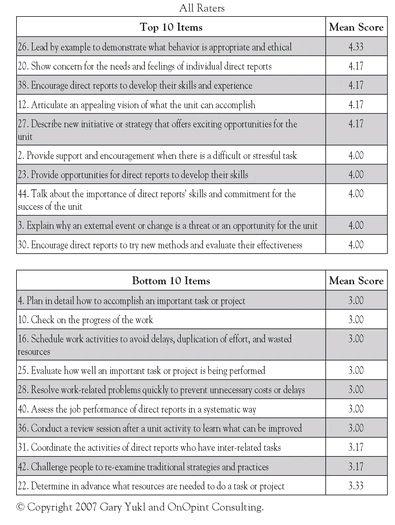
Exhibit A.5 Flexible Leadership 360 Feedback Report, Gap Analysis Profile

Leadership Mirror® Featuring Targeted Feedback®/Patent Pending
Development Dimensions International (DDI)
Leadership Mirror® is a web-based, multisource, multilingual feedback tool from Development Dimensions International (DDI). Its scalable platform enables organizations to conduct global, enterprise-wide assessment initiatives involving large populations, small teams, or individuals. Its highly flexible design allows an organization to choose from one of seven standard, well-researched surveys. In addition, Leadership Mirror® is flexible enough to be either partially or completely customized. This content flexibility enables organizations to tailor the survey content to address the target population’s specific needs.
Leadership Mirror® is unique among 360-degree survey platforms in that it offers two different approaches to multi-source feedback. Both approaches enable raters to include quantitative and qualitative feedback.
• Approach 1—Leadership Mirror® enables administrators to quickly construct traditional 360-degree surveys that allow respondents to (1) rate each competency’s key behavioral actions on a standard or custom numerical rating scale; (2) include qualitative comments on a competency-by-competency basis; and (3) respond to a final, overall open-ended question.
• Approach 2—Targeted Feedback®/Patent Pending is the second option and is built into Leadership Mirror®. This innovative DDI multisource alternative eliminates the discomfort raters may feel when evaluating or judging subjects and provides in its reports a much simpler view of their strengths and development areas.
At first glance, a Targeted Feedback® survey looks like a conventional multi-source instrument, complete with a list of competencies and definitions. However, the respondents’ task is different from that in all other multisource instruments. Instead of rating each competency on a numeric scale, respondents are only asked to select up to three strengths for a subject and up to three areas for growth (weaknesses) . (See Exhibit A.6 .)
Next, the survey displays the key actions (sub-behaviors) for each of the chosen strengths and growth areas and asks each respondent to indicate which ones contribute to the subject’s strengths in that area or, conversely, which ones are driving the need for growth. (See Exhibit A.7.)Respondents also are asked to further describe the strengths and growth areas by writing behavioral examples.
Targeted Feedback® Reports
Outputs from Targeted Feedback® are considerably different from those obtained via traditional multi-source instruments, because they focus subjects’ attention on fewer areas and help them clearly understand their most important strengths and growth areas. There are no averages, ranges, norms, or dispersion statistics to distract or confuse them, and subjects don’t get lost in slight or obscure variations across a large list of competencies and key actions.
The unique Targeted Feedback® Comparison Report shows a graphic comparison of the choices made by the various respondent groups. It highlights the three competencies that were most frequently chosen as strengths as well as the three most often selected as growth areas.
The report arranges results into a series of color-coded blocks displayed across rows by competency and in columns represented by respondent group (peers, direct reports, customers, etc.). Areas of agreement (consistent color) and areas of disagreement (mix of colors) clearly stand out.
Exhibit A.6 Leadership Mirror® Sample Select Strengths and Areas for Growth

Exhibit A.7 Leadership Mirror® Sample Srength
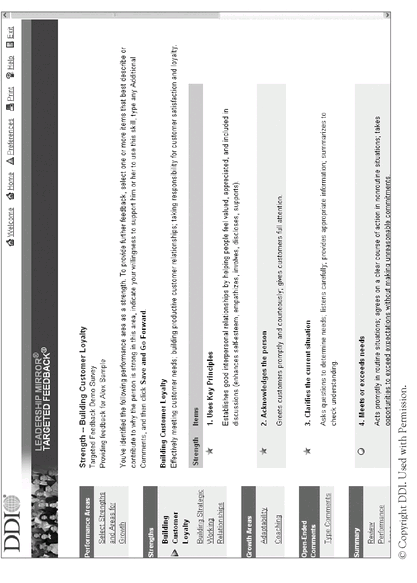
The report is initially set up to give each subject’s manager the preeminent position; this tends to keep the focus on the subject’s partnership with the manager. However, the system’s HTML reporting capability allows a subject to re-sort his or her report by any respondent group if desired.
The graphic representation ameliorates the complexity and confusion of the traditional, statistic-centric approach, making it much easier for subjects and their managers to focus on priorities and create more effective development plans. (See Exhibit A.8.)
When to Use Targeted Feedback® or a Traditional Multisource Approach
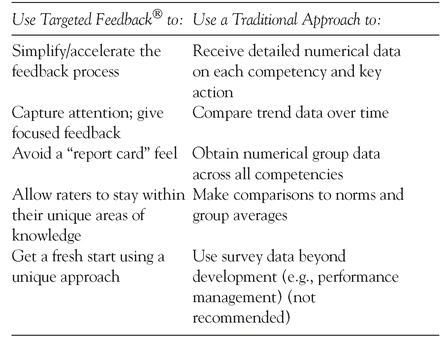
DDI has applied for a U.S. patent for the unique characteristics of the Targeted Feedback® approach to multisource feedback systems.
Exhibit A.8 Targeted Feedback® Sample Respondents’ Comparison Respondents: Total providing feedback =10 Total invited= 10

Implementation and Realization Consulting
DDI provides a variety of development and support tools that enables participants to experience measurable, sustained behavioral change.
DDI’s planning strategy includes the following ongoing support to clients throughout the entire 360-degree implementation:
• An on-site planning and strategy kick-off session during which DDI works closely with the client’s project team to map out a comprehensive communication strategy that involves all key groups
• Consultants who can help to select competencies and key behaviors, configure the survey design, and identify distribution methods
• Training for survey creator(s) and participants on how to use the instruments and response options
• Feedback and coaching delivered by a consultant in one-on-one or group feedback sessions
Your Survey Is Complete: What Now?
Leadership Mirror® provides an array of built-in resources to allow subjects to take immediate action on their development.
What Now? Booklet. Everyone who receives a multi-source feedback report from DDI also receives a copy of What Now? a booklet authored by DDI co-founder and CEO Dr. William C. Byham. This booklet lays out a strategy for understanding the report and using the insights gained from the feedback. The booklet also focuses on aligning the individual’s and organization’s needs in planning and implementing development activities as well as on involving the individual’s manager for insight and support.
Development Guides. DDI offers online access to a library of development suggestions and resources for each of the more than one hundred competencies in the DDI competency taxonomy. Development guides serve as excellent aids for individuals who want to grow in a given area. For each competency a guide not only elaborates on the competency’s definition and contains bibliographies and brief synopses of books and articles pertinent to development, but also cites appropriate training programs and on-the-job suggestions for improvement.
OPAL®
To further expand the platform’s flexibility and breadth, clients also have the option of seamlessly linking Leadership Mirror® at the competency or behavior level to OPAL®, DDI’s online performance and learning system. OPAL® is a complete competency development and day-to-day job performance resource. It presents the tools (insightful information, action planners, assessments, worksheets, performance tools, and more) individuals need to build skills and perform better on the job.
Custom Development Resources
Leadership Mirror® allows a survey creator to add in “custom development resources” that enable a survey subject to link to additional development resources outside the system, such as a specific website or organization-specific documents.
How Clients Are Using Leadership Mirror®
A well-known health insurance company with 4,400 employees partnered with DDI to design an eight-course management development program (MDP). Before beginning the MDP, each leader is required to participate in a Leadership Mirror® survey to identify strengths and areas for development. The first round of leaders who went through the program used the traditional approach, rating competencies on a numerical scale. While participants found the Leadership Mirror® feedback useful, they felt that the numerical ratings were a little too detailed and would have preferred more focused suggestions for improvement. In light of this feedback, the organization switched to the Targeted Feedback® approach.
Individuals receive their feedback reports in an “Interpreting Your Reports” group feedback session, followed by five individual coaching sessions throughout the year with a DDI consultant. In the first session the subject builds his or her development action plan using Leadership Mirror® resources, such as the What Now? booklet, development guides, and OPAL®. In the following sessions, the consultant provides ongoing coaching to ensure that the subject has enlisted the support of his or her manager and is making progress on development.
DDI believes that training and development efforts are most successful when participants have a true understanding of their own specific strengths and development needs. For many individuals Leadership Mirror® has provided this powerful insight, which not only has added to the value of an organization’s specific training initiatives, but also has ultimately led to behavior change and sustainable results.
VOICES®
Korn/Ferry
VOICES® Multi-Rater 360 Degree Feedback System
VOICES® is a state-of-the-art, web-administered 360-degree feedback system that is firmly based on established best practices for multi-rater surveys. VOICES® allows the learner (the person being rated) to be assessed on the sixty-seven “competencies” and nineteen “career stallers and stoppers” in Lominger’s LEADERSHIP ARCHITECT® library. All competencies and stallers and stoppers are research-based and have been extensively validated. Additionally, surveys can be administered at different levels of analysis above including eight factors, twenty-six clusters and 356 behavioral aspects. Lominger’s seven “international focus areas” are also available for inclusion in the survey. VOICES® is specifically designed to be used as a developmental tool. The feedback provided by VOICES® helps to reveal the following data that is critical for development:
• How a learner’s job behaviors are perceived by those around him or her
• Which of these behaviors are considered important for success
• How others’ ratings compare to the learner’s self ratings
VOICES® is not designed to be used for performance appraisal purposes. For those looking to assess behaviors in the context of performance, we recommend Lominger’s Performance Management Architect®.
Survey Administration
VOICES® is a highly customizable and versatile feedback system that includes some of the following features:
• Raters can be assigned to six separate categories. Only the self and boss categories stand alone. To protect anonymity, other categories such as peers and direct reports require feedback from at least two raters for the data to be displayed in the report.
• The language for rater invitations and reminders is customizable. Multiple reminders can be sent on dates specified by the customer.
• Any combination of Lominger’s sixty-seven competencies can be included in the survey. Custom competencies can also be defined.
• VOICES® features three possible rating questions: Skill, Importance, and Overuse.
• Raters receive real-time feedback on the distribution of their ratings. This helps to discourage ratings bias.
• Raters can provide narrative comments on specific competencies or enter notes into a general comments category.
• Items appear in randomized order so the impact of rater fatigue is minimized.
• The survey can be administered via the full-service support of our Global Survey Center or customers can choose a self-serve option.
• VOICES® is currently available in English, French, German, Spanish, and Italian, with more translations currently underway.
Survey Report
A range of options is available for generating the survey report. VOICES® features up to twenty possible report sections, with more currently in development. These include reports highlighting blind spots, hidden strengths, EQ and the alignment of skill and importance ratings. (See Exhibit A.9 for a sample of the Group Summary on Skill Ratings report section.) Customers can choose which report sections to include or not include and can also specify the sequence that report sections appear in. Multiple display options are available including rater agreement indicators and comparisons to normative groups. Reports are available in either .pdf or printed formats. In addition to individual learner reports, group reports that calculate the average ratings of multiple learners are also available.
Survey Feedback
VOICES® reports are confidential. The learner owns the feedback and receives the only copy of the report. Any decision to share the feedback with others, either directly or indirectly, is made by the learner. All feedback is given by a certified VOICES® feedback coach. The coach helps facilitate the learner’s interpretation of the feedback report and put together a developmental plan aimed at strengthening specific competencies.
Ongoing Development
Multiple tools can be used by the learner and feedback coach to support ongoing development efforts. These include FYI For Your Improvement™, CAREER ARCHITECT® Development Planner, and Broadband Talent Management™. These resources provide practical, experience-tested remedies for developing specific competencies as well as different developmental pathways to follow in the wake of 360-degree feedback.
Measuring Improvement
Another important resource linked to VOICES® is Development Tracker™, a mini-survey that provides a way to measure improvement following 360-degree feedback. This is an efficient and effective way of tracking development in the two to three years that might elapse between repeated administrations of VOICES®. The survey helps organizations measure the impact of a learner’s awareness of his or her developmental needs. It also measures the impact that coaching or learning has had on development. (See Exhibit A.10 for a sample of the Development Tracker™ report.) Development Tracker™ is best administered six to nine months after receiving VOICES® feedback.
Exhibit A.9 VOICES® Group Summary on Skill Ratings Report

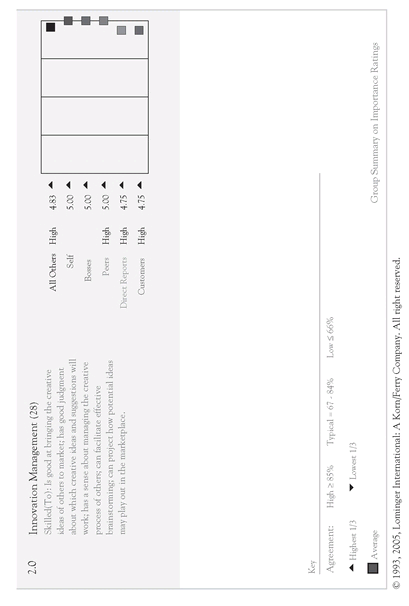
Exhibit A.10 Sample Development Tracker™Report
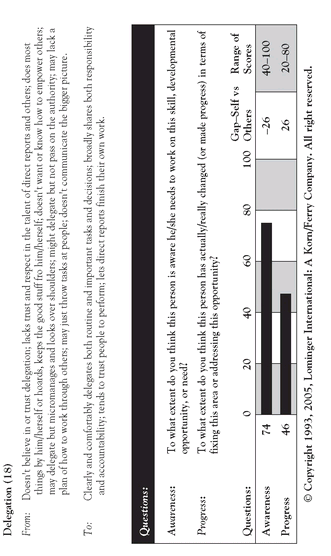
Profilor
Personnel Decisions International (PDI)
The PROFILOR® —Focus on Development
The PROFILOR is a 360 feedback tool used for development purposes and includes competency models from senior executive-level to individual contributor positions created by Personnel Decisions International (PDI). The PROFILOR can also be customized to reflect an organization’s terminology or to fit its competency model. In fact, the majority of PDI’s 360 solutions are tailored to meet client needs.
The PROFILOR feedback reports provide practical, well-rounded insights into job performance, strengths and development needs, as well as paint a comprehensive picture of the specific skills that an individual needs to develop to enhance performance. They also provide a basis for creating an individualized, actionable development plan by including developmental recommendations for each behavior identified as a development need. These recommendations are for on-the-job action steps and stretch assignments and include books and seminars as development resources. A variety of norms are available to provide comparisons to external benchmarks.
Talent View of Performance® —Focus on Performance
Talent View of Performance is a web-based, multi-rater tool designed to be used for performance management or succession planning. It incorporates behavior-level performance anchors commonly referred to as Behaviorally Anchored Rating Scales (BARS). Talent View of Performance provides valid, legally defensible performance data for decision making at all levels of an organization. It can be combined with measures of potential to provide quantifiable information for talent management decisions.
Organizations receive a Stacked-Rank Report of all individuals that can be used for decision making, and individual participants receive a detailed feedback report that not only shows scores for each competency and behavior, but also provides detailed developmental suggestions and open-ended comments from their raters. This information provides a solid foundation for development planning and decision making at all levels of the organization. The products are compared in Table A.1.
Time2Change® —Focus on Change
Time2Change is a short, follow-up survey that measures the degree to which employees have improved in areas targeted for development. Time2Change measures development change directly, giving participants valuable, motivating feedback on the extent to which others see their performance improving, and it gives an organization quantifiable information about the extent to which employees are developing.
Six to twelve months after a development initiative has occurred, each participant selects up to ten items or behaviors from a standard PROFILOR or Talent View of Performance model. These items correspond to aspects of the performance each has have targeted for development, either as strengths to leverage or opportunities to develop. The software then creates a targeted 360-degree feedback survey for just those items. Participants then determine whom they want to assess their improvement in those targeted areas. Open-ended comments are collected from respondents about specific development activities they have observed. It can also measure whether behavioral change has occurred as the result of other development initiatives such as training programs, assessments, and coaching.
Table A.1 PDI’s Point of View About 360-Degree for Development and Decision Making

Individual feedback reports are generated from the results. The reports incorporate the PDI Development Pipeline® showing the necessary and sufficient conditions that must be in place for behavioral change to occur. Feedback is provided on overcoming obstacles to development. The reports are easy to read and graphically display the results. An optional Time2Change Organizational
Exhibit A.11 Sample Change Progress Report

Assessment Report aggregates data across participants to provide the organization with information such as: what behaviors participants most frequently targeted for development; what behaviors participants were able to develop readily; what behaviors were most resistant to change; and what aspects of the organization’s culture inhibited or promoted development. (See Exhibit A.11.)
Leadership Practices Inventory
Assessing How Leaders Get Extraordinary Things Done
James M. Kouzes and Barry Z. Posner
The story of the development and use of the Leadership Practices Inventory(LPI)—our thirty-item, 360-degree behavioral assessment tool—is one of a journey of transforming the myth that leadership is mysterious and beyond the grasp of mortals to providing evidence that leadership is an observable and learnable set of behaviors that can be measured and consequently developed and enhanced. Motivated by a desire to demonstrate that “leadership is everyone’s business,” we’ve conducted studies over more than twenty-five years that examines what ordinary people did to get extraordinary things done.
We discovered and empirically documented The Five Practices of Exemplary Leaders. When at their personal best, people who are leading:
Model the Way—Leaders clarify values and set the example. Inspire a Shared Vision—Leaders envision the future and enlist others in a common vision.
Challenge the Process—Leaders search for opportunities and experiment and take risks.
Enable Others to Act—Leaders foster collaboration and strengthen others.
Encourage the Heart—Leaders recognize contributions and celebrate values and victories.
Copyright © 2008. James M. Kouzes and Barry Z. Posner. All rights reserved. For more information about this leadership assessment, please visit www.leadershipchallenge.com/go/research
Since we began our research, we have reviewed more than one million responses on the Leadership Practices Inventory. Every year we conduct internal analyses of the psychometric properties of the instrument and make certain that it remains reliable and valid. For example, internal reliabilities for the Five Practices are very strong and have been consistent over time. The underlying factor structure has been sustained across a variety of settings and populations, and empirical results continue to support the LPI’s predictive and concurrent validity. Studies by more than 350 independent scholars around the globe confirm the reliability and validity of the LPI (see www.theleadershipchallenge.com/research for more information).
The LPI has application for personal reflection across a variety of organizational settings, and users have included individuals in both managerial and non-managerial positions, as well as students, and volunteers. Likewise, the LPI has been successfully used across the United States and increasingly employed in other parts of the world (and is available in several foreign languages, such as Spanish, French, German, and Chinese). The Observer form, available for co-workers, peers, colleagues, supervisors, direct reports, clients, friends, and others, significantly extends the feedback available beyond only self-reflection.
Another unique feature of the LPI is that it does not have to be purchased from or scored centrally by a licensed or third-party training or testing company. Because we believe that leadership is everyone’s business, we developed an instrument that is available directly by any individual (consultant or organization) from either the instrument publisher—Pfeiffer, an imprint of Wiley.—or from one of the authorized providers of The Leadership Challenge® Workshop (listed on www.leadershipchallenge.com).
From Assessment to Improvement: Using the LPI in Training and Development
While the LPI is used extensively in assessment centers and research projects, its most common use is for leadership development, and the most common format for development is a workshop. This experience typically involves pre-work, scoring, model overview, feedback, personal reflection and observation, practice, and application planning. The LPI is available in both a hard-copy (print) format as well as electronic (online or web-accessed). The online version significantly assists in the administration and scoring of the instrument.
Pre-Work and Scoring
At least two to three weeks prior to a leadership development workshop, participants receive a pre-work package that includes the LPI Self and five to ten LPI Observer forms (the online version makes this an unlimited number). To provide a safe environment for respondents and participants, the forms are usually distributed by a third party, most commonly an internal human resources development staff member or an external training provider.
The LPI can be self-scored or centrally scored (in-house or on the web). Since anonymity and data security are frequent issues, the completed LPI forms are usually returned directly to a program administrator for scoring. A self-scoring option is available that puts the tool directly in the hands of the feedback recipient, although this scoring alternative is seldom used.
The program administrator can either manually transfer Self and Observer ratings to the five practice grids or enter data into a computerized scoring program that performs all functions electronically. Once scoring is complete, the administrator prepares a confidential feedback report for each participant (or prints this directly from the website).
Model and LPI Overview
In workshop settings, facilitators present The Five Practices model before they distribute individual LPI feedback. The overview gives participants a context for interpreting their feedback and applying it to on-the-job situations. As an alternative to live presentation, a video on The Leadership Challenge is available.
Following an overview, the program facilitator orients participants to the LPI feedback and briefly explains the origins of the instrument, reviewing these essential points:
1. The LPI is designed to measure exemplary leadership behaviors and practices that have been identified by Kouzes and Posner in their research as the actions that explain how leaders get extraordinary things done in organizations.
2. The LPI is not about attitudes and intentions but about actual behavior. It does not evaluate IQ, style, or personality. Neither does it measure broader management behaviors. It only measures leadership practices that were shown to be effective in the Kouzes and Posner research.
3. Each statement on the LPI measures one of the specific behaviors that make up one of the five leadership practices in Kouzes-Posner model.
4. There are six behaviorally based items measuring each practice, for a total of thirty items.
5. Each statement asks respondents to indicate the extent to which the leader being assessed engages in that behavior on a scale ranging from 1 (almost never) to 10 (almost always).
6. The LPI has passed all relevant statistical tests of reliability and validity. This means that measurement errors are minimal, and correlations between practice and effectiveness is very strong.
With this background provided, the program facilitator then distributes the confidential feedback reports to each participant.
Feedback Display
If the program facilitator has chosen the computer scoring option, the printout that each participant receives provides fourteen pages of data for feedback (more pages may be generated for sample sizes beyond twelve respondents). Printouts from the online version are roughly the same.
The first page is typically a cover sheet with the individual’s name, date and organization, program, or company name. The next page summarizes the data providing: (1) the self-rating on each of the five practices; (2) the average or mean score of ratings given by all observers for each practice; and (3) the ratings given by each observer on each practice. Observer ratings remain anonymous and are coded as letters or letters and numbers if there is more than one of the same observer type. All formats of the feedback report (whether using the LPI computer scoring software or web-based version, as well as the manual scoring method) maintains respondent anonymity.
The Five Practices Summary page is shown in Exhibit A.12. The page following this shows the same information but displays it in a bar graph because some people may learn better when presented numerical data in a graphic manner. The following pages present data for each leadership practice in a similar fashion. The first page presents numerical or data summaries and the second page shows bar graphs, of self-ratings and average scores from observers by respondent category.
The penultimate page of the feedback report displays all thirty LPI items, from highest to lowest based on the average score from observers. While the first summary page provided a summary by practice, this last page provides an item-by-item summary. Because the items are ranked from most to least frequent, this display is useful for targeting specific behaviors for improvement. The report ends with the Percentile Ranking page. This page compares Self scores and those of the Observers to the scores of the LPI normative database.
If participants or sponsors have chosen to use the manual scoring option, grids and line graphs in the self-analysis guidebook are filled in by respondents during the workshop. The data can also be filled-in by hand by third-party administrators prior to the event.
Exhibit A.12 Sample LPI Data Summary

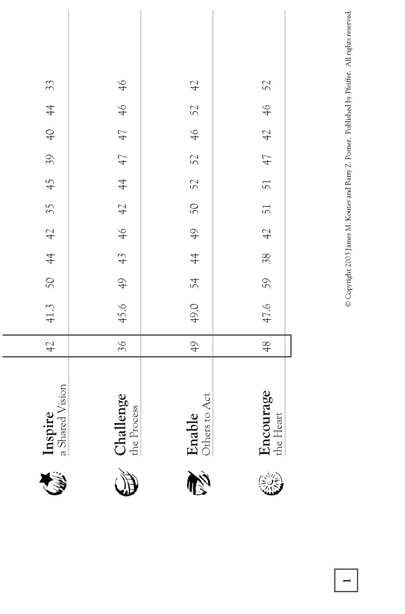
Feedback Review
It has been our experience that participants are anxious to review their own feedback. We recommend that some explanation of the conceptual model underlying the organization of the feedback (that is, The Five Practices of Exemplary Leaders) should be provided before the program facilitator guides them through a more thorough examination of the data. In addition, the facilitator needs to explain briefly how the data in the LPI Feedback Report is organized and answer any questions participants may have about the instrument itself (although mostly needed is a simple assurance that the LPI is a reliable and valid instrument that can help people understand what it takes to become a better leader). Consequently, program leaders distribute the confidential forms and allow people about five to ten minutes to quietly leaf through their data.
Program facilitators should walk the group, fairly quickly, through a page-by-page, item-by-item analysis of the data, using a “sample participant” LPI as a reference. Facilitators remind participants to look for messages, not measures. In particular, they direct people’s attention to their own perceptions of what their strengths and areas for improvement are and how their self-perceptions are reflected in others’ assessments. Any discrepancies between observer and self-ratings, along with any sharp variations among the observers themselves, should be noted and analyzed for possible causes. Finally, participants are asked to indentify the three or four strongest messages they are hearing about their leadership, as well as the one or two practices (three or four specific behaviors) they want to target for improvement.
Before concluding the LPI review, participants plot their self-ratings and observer averages on a percentile ranking graph. This grid allows participants to compare themselves to the norms that have been established for the LPI. Computerized feedback reports will automatically plot these comparisons.
Reflection
After walking through the mechanism of the feedback report (data), participants are given time to more thoroughly review the information, analyze their results, make notes to themselves, and record their interpretations. There are usually a number of major points and sometimes possibly hundreds of different data points to absorb. Almost everyone will need at least thirty to forty minutes to review their feedback, while some may need (or want) many hours to fully appreciate the meaning of the messages. Rather than try to absorb all of this in one sitting, in multiple-day workshops, participants should return to the data at least once for each leadership practice. This is what we do in our own The Leadership Challenge® Workshop.
Generally, participants are asked to share their LPI scores with one other participant. The partner’s role is to view the data from another perspective and to offer peer support for development. Because this information is personal, it is always the participant’s decision whether to share scores. The issue of sharing information is more sensitive when participants are from the same organization or work group than it is when they are from many different organizations or even parts of one large enterprise.
Practice and Application
Feedback alone is of limited benefit to the recipient unless it is followed by opportunities for goal setting, mastery, and confidence building. This is why, in The Leadership Challenge® Workshops offered by Master Facilitators, which last two or three days, participants experience each practice, observe what to do to perform it well, have opportunities to try out specific behaviors, receive additional feedback on their performance, apply their lessons to their own settings, and make commitments on how they will follow through back in their own settings. Similar processes should be observed in other workshop or feedback sessions.
Center for Creative Leadership’s Assessment Suite
The mission of the Center for Creative Leadership (CCL) is to advance the understanding, practice and development of leadership for the benefit of society worldwide. Since 1970, CCL has continuously studied leadership. They conduct research, produce publications, and provide a wide variety of educational programs and assessment products to leaders and organizations in the public, corporate and nonprofit sectors. For more than thirty years, the Center for Creative Leadership has been internationally recognized as a leading resource for understanding and expanding the leadership capabilities of individuals and organizations.
CCL has a strong belief that development has to begin from a point of self-awareness-taking an honest look at oneself, and how they are perceived by others. Through a 360-degree assessment process, managers/leaders can solicit feedback from raters across five different types of relationships (Immediate Boss, Superiors, Peers, Direct Reports, Others). In the feedback report, they see the how the perceptions from their raters compare not only to their own “Self” perception, but also how their own leadership “picture” compares to other leaders in CCL’s extensive normative database. Each of the 360 assessments is accompanied by a Development Planning workbook which the manager/leader can use to create a detailed development plan and action steps specifically designed to address their development goals.
Research-Based Assessments
Since the early 1980s, CCL has conducted research projects resulting in the development of 360-degree feedback instruments. Each of CCL’s “standardized” 360 assessments (intact assessment models) offers a model of managerial or leadership effectiveness based in the research behind the respective instrument. Through ongoing studies, these assessments have each been proven continuously psychometrically sound as well as relevant to practicing managers, leaders, and executives. In all, these studies involved hundreds of thousands of successful managers and leaders. The standardized assessment models in CCL’s Assessment Suite are Benchmarks®, Prospector®, and Executive Dimensions™ (see research summaries below). CCL’s fourth assessment in the “suite”—360 BY DESIGN®—is a customizable instrument that offers CCL’s entire library of ninety-nine research-based leadership competencies. For further information about each instrument’s research background, including the validity and reliability studies and normative databases, contact CCL.
Benchmarks® Research Background
Lessons of Experience—These seminal studies examine how executives grow and develop over the course of their careers. Executives who participated in the studies reflected on critical experiences in their careers and what skills and perspectives they learned from these experiences. The lessons that they reported learning are represented in the sixteen competencies assessed in the Skills and Perspectives section of Benchmarks.
Executive Derailment— These studies compared and contrasted the careers of successful executives with executives whose careers had derailed, in order to determine what was needed to be successful at the top. Derailed managers were defined as those whose careers and accomplishments were involuntarily below the level of achievement expected by the organization; they had been demoted or fired, or their careers had plateaued.
Executive Dimensions™ Research Background
Executive Competencies— The objective of this research was to identify key competencies for executives. The identification process involved an extensive literature review and an empirical study using data collected from senior executives attending the Center for Creative Leadership’s Leadership at the Peak program. Research-based taxonomies were first used to identify a set of executive competencies related to effectiveness. Then additional competencies were gathered through cases from executives and subject-matter experts (specific descriptions of leadership behavior they observed at the top levels in organizations). Finalization of the competencies was determined through a psychometric analysis of data from approximately five hundred executives and three thousand of their observers.
Prospector® Research Background
Openness to Learning and Development—Under a grant from the International Consortium for Executive Development Research (ICEDR), Morgan McCall and his research colleagues investigated dimensions associated with: people’s ability to learn over the course of their careers and the skills important for effectiveness in expatriate assignments. The research subjects were international executives from a variety of global corporations.
360 BY DESIGN
In addition to competencies identified in the research studies cited above, 360 BY DESIGN also includes competencies from additional studies CCL conducted that focused on entrepreneurial leadership, managerial effectiveness, and global leadership capabilities, for a total of ninety-nine competencies organizations choose from to create their own “customized” assessment model.
Some samples of feedback reports in their Assessment Suite are provided in Exhibit A.13, Exhibit A.14 and Exhibit A.15.
Exhibit A.13 Sample Scoring for Importance

Exhibit A.14 Sample Norm Group Comparisons

Exhibit A.15 Sample Profile for Leading Employees
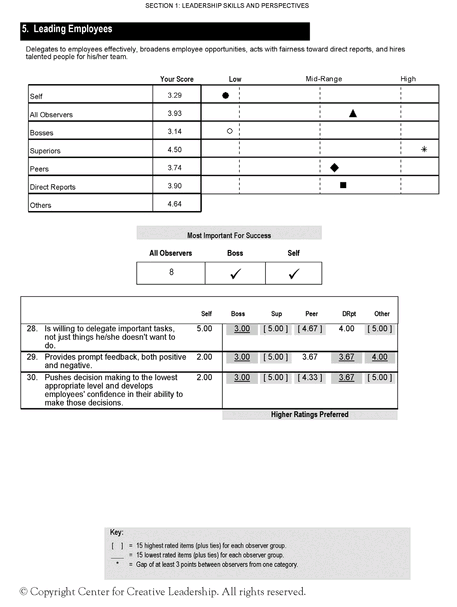
..................Content has been hidden....................
You can't read the all page of ebook, please click here login for view all page.
